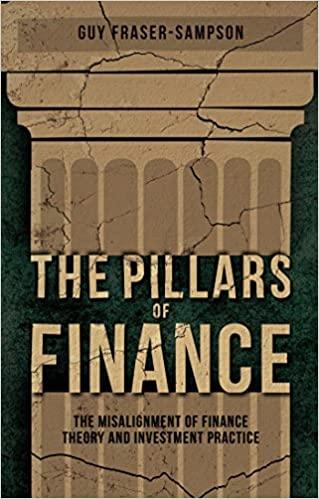Question
Asset substitution occurs because debt holders own the lower tail of the distribution of firm value, while equity holders own the upper tail. This is
Asset substitution occurs because debt holders own the lower tail of the distribution of firm value, while equity holders own the upper tail. This is the cause of the conflict of interest because some decisions hurt the lower tail but help the upper tail (and can help or hurt the overall value of the firm). Now consider two projects, the riskier one also has a lower expected return. Each has only two possible outcomes, one if there is a depression (D), and one if there is prosperity (P). The probability of each outcome is 0.5. Each project requires the same initial outlay, say $800.
Project 1: Value if D = $500, Value if P = $1500, Expected value = $1000, Expected return = 200/800 = 25%
Project 2: Value if D = $0, Value if P = $1551, Expected value = $775.5, Expected return = -24.5/800 = -3.06%
We could get more detailed information and for example take account of the s of each project (and note that Project 2 will have a higher ), but for our purposes we do not need to consider other detail. Clearly, Project 1 is the better investment. An owner-managed firm with no debt would no doubt select Project 1. What happens when an owner-managed firm has borrowed for one-period with debt of face value $600? The basic point is that the payment of $600 is sunk cost: if the firm is going to default, then it couldnt care less about how big the default is. It wants to generate more income when not in default. Here are the cash flows to equity when the debt of $600 is in place:
Project 1: Value if D = $0, Value if P = $1500-$600 = $900, Expected value = $450
Project 2: Value if D = $0, Value if P = $1551-$600 = $951, Expected value = $475.5
Hence the levered firm would select Project 2, despite its lower net present value, because it has a higher present value conditional on not leading to default. The equity owner owns the upper tail, and is only concerned with the returns he owns. Note that no matter how the equity owner values the cash flows if prosperity state is reached, he prefers Project 2 since both projects have the same cash flows if depression state occurs but Project 2 has higher cash flow of prosperity state occurs.
1.What are the cash flows to debt with face $600 given Project 2?
2. What is the expected payment received by debt holders in this case?
3. If debt holders require a 10% expected rate of return, how much is raised initially when bonds with a face value of $600 are sold?
4. Since all projects require $800 of initial capital, the owner will have to put up his own capital, equal to $800 minus the amount raised from debt holders. How much is this? Call this amount of capital K. This investment entitles the owner of the cash flows described above when Project 2 is undertaken (i.e., 0 if depression occurs and $951 if prosperity occurs). Would the owner be satisfied with this result?
5. Suppose an alternative financing option is to issue bonds with a face value of $200, and further suppose that the owner had enough capital to finance the remainder of the project. Which project would the owner select with these bonds in place? Show the expected value to the equity holders for the two projects.
6. Given the project choice that these bonds induce (in part 5), compute the cash flows to bondholders, the expected payment to bondholders, and the amount of money these bonds would raise if bondholders require a 10% expected rate of return.
7. If bonds raise the amount you computed in part 6, how much does the owner have to put up to raise the $800? What expected payment does he receive for this investment? If he can earn 10% expected return on this alternative investment, is this better or worse than the return he receives with the debt of $600? Which capital structure would he choose?
Step by Step Solution
There are 3 Steps involved in it
Step: 1

Get Instant Access to Expert-Tailored Solutions
See step-by-step solutions with expert insights and AI powered tools for academic success
Step: 2

Step: 3

Ace Your Homework with AI
Get the answers you need in no time with our AI-driven, step-by-step assistance
Get Started


